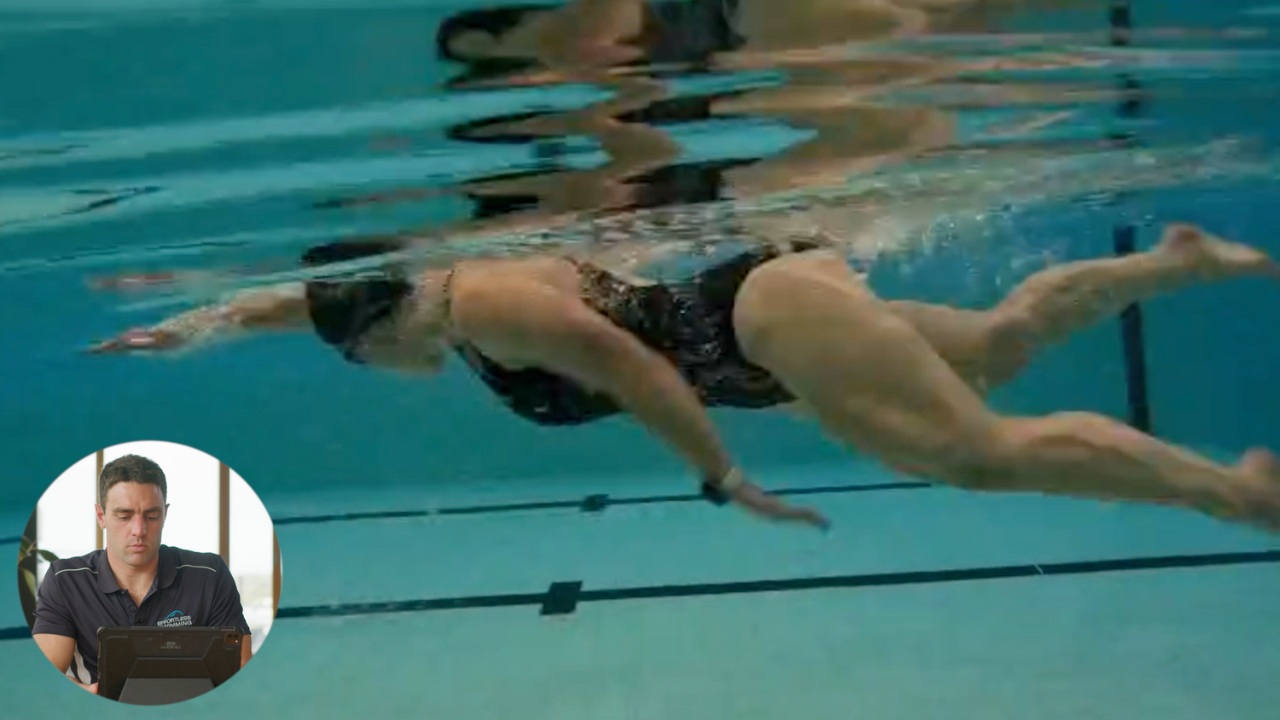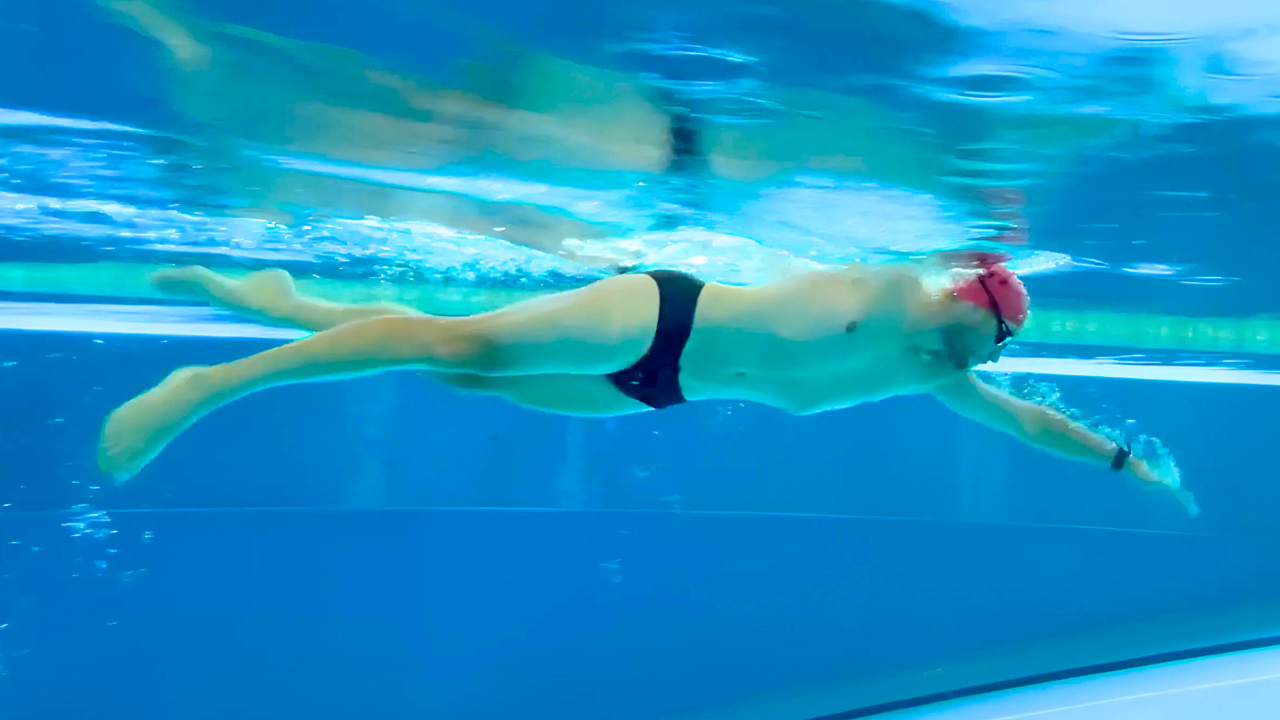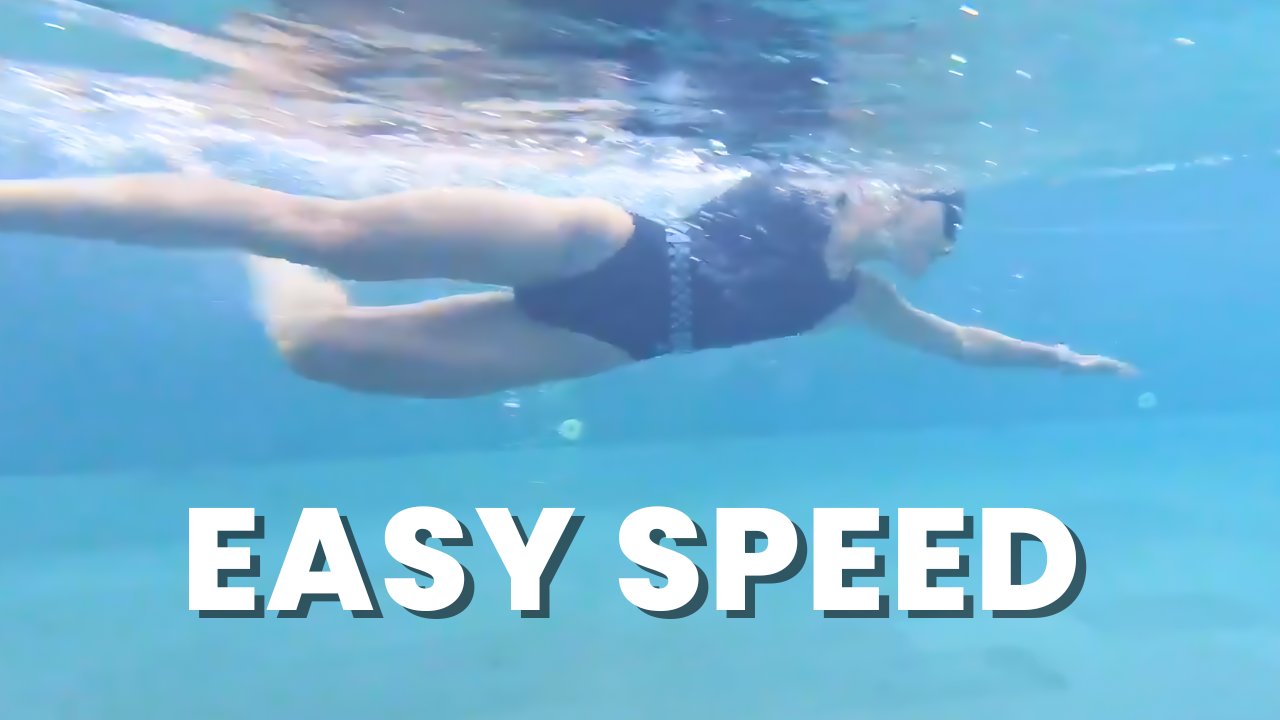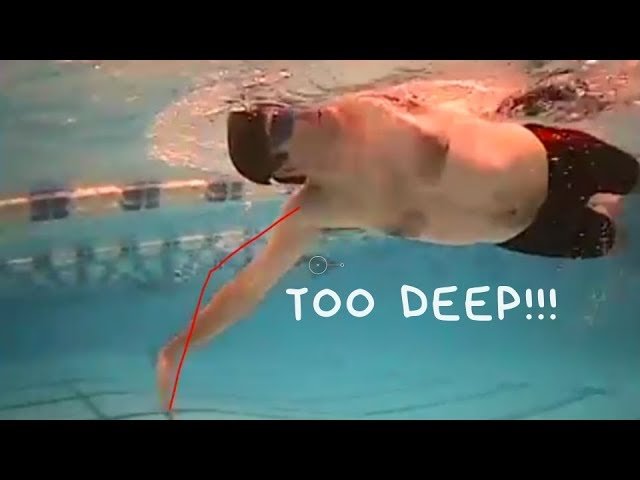In this video, we look at Tab Jones who first attended a clinic in 2016. At the time she was swimming her 1900m race in 2.03/100m pace, and her most recent race was done in 1.31/100m pace. We’ll show you how she improved the propulsive phase of the stroke (her catch and pull) and her kick to be more effective and less effort.
Transcription:
Quiet position at starting. The fingertips are pointing down. You know we like to look at the angle as the hand passes underneath the shoulder or just before it. That’s spot on, 115 degrees. We like it to be 100 to 120. We talk about that as the Power Diamond.
Hi. Brenton here from Effortless Swimming. In today’s Feedback Friday, we’re looking at a swimmer who’s taken 32 seconds off her 100-meter pace across a 1900-meter swim, so a half Iron Man distance swim. Now you might recognize Tab from such viral sensations such as how to take 20 seconds off your 100-meter pace. If you haven’t seen that video, click the link above. We did a video a little while ago that’s gotten over a million views and had a lot of good feedback.
Now Tabitha’s gone from a 2:03 pace originally this is about three years ago, down to a 1:31 pace per 100 meters. This is actually for a 1500-meter swim, so not far off that 1900-meter distance. We’re going to have a look at what changes she’s made over those last three years that has helped contribute to that improvement, and then we’re going to look at what is she focusing on now. Now a big part of this improvement has come from more experienced training, fitness. All that stuff absolutely helps. Here, we’re looking mostly at the technical side of things, so there are a couple of key things I want to point out.
Now the very first one is the catch. This is something that she has made a huge difference with. Over the last couple of months. So Tabitha has come along to a few of our highway camps in Thailand, she’s come along to a number of clinics and we’ve seen really good improvements over that time. And The Catch is probably the most notable one. So if we look at the catching. I want to show you a video. Let’s have a look at the Catch three years ago, with her stroke.
Now in seeing this video, she’s dropping out but quite a bit, pressing down on the water, early on in the catch. So there wasn’t that much propulsion coming from the catch itself.
Now if we look at it now, three years later, have a look at where it starts, this is a great position. So if you’ve seen any of that videos, you’ll know we want the fingers by the wrist, wrist below the elbow. That’s where we want to start the catch, spot on. Now the fingertips then point down to the bottom of the pool. And right here when she finishes that catch, you know that we want to have a look at how’s the catch. Is it in a high elbow position or a dropping elbow? So if we draw this imaginary line from the shoulder to the fingertips, we have a look at the elbow. That elbow is above that straight line which just means, yes she’s in a high elbow catch position and that’s to be clear where we want to be set up.
Now you’ll know from watching out our videos, you don’t need to go for anything extreme. Especially if you’re an adult doing a triathlon, doing open water swimming, you don’t need to be like, and in thought, and have this very, very high elbow catch. Because that might not be comfortable and it might not be a very strong position for you. All we want is for that elbow to be slightly above that imaginary straight line that we just looked at.
So with Tabitha, really, really nice set up on this left side. Definitely, the hand is great and pressing back very well there. That’s good. Then on the right side, similar thing. Now the fingertips do come up a bit, so we do want to work on getting that to come down a little bit more, which we’ll look at in a moment. But the catch itself, this position’s really good. So she’s set up very well there. And then as she continues on, you’ll see the fingertips pointing down. And again, if we draw that imaginary straight line, the elbow is above it. So, on both sides, that’s probably been the most notable change in her stroke. It’s a much better catch position.
Now on this right side, I do want to go a little bit deeper with the hand as you’ll see when we look at the front view. It’s just not going quite deep enough. The elbow’s actually staying a little bit too close to the surface of the water. Now I do hear some coaches talk about high elbow catch is actually you want the elbow near the surface. I don’t necessarily agree with that. I see a lot of really good swimmers actually going a little bit deeper so, in terms of a high elbow catch, it’s not you need the elbow right near the surface. It’s actually quite a bit below it, which we’ll have a look at from the front just to make that a little bit clearer. But overall, that catch has improved a lot.
Now the second thing I want to show you here is the kick. In the video three years ago, you’ll see in her kick, if we have a look at it now, that she was very kicking heavy. She was over kicking and her knees are probably bending a little bit too much. Here, the timing of the kick is much better. So you’ll see that she’s not working the legs quite so hard, so it’s much better timing with the rest of the stroke. And you’ll also see that it’s not quite as big, so it’s not much knee bend. So that also helps with the overall rhythm and timing of the stroke.
So they’re the two biggest changes that I’ve really noticed. I just want to show you the front view here now. So in terms of the catch again, this is what we’re looking at. So quite position to start in, fingertips are pointing down. You know we like to look at the angle as the hand passes underneath the shoulder or just before it. That’s spot on 115 degrees, we like it to be 100 to 120. We talked about that as the Power Diamond. Think of this as a sort of half diamond on the side, that’s roughly the position we want to be as the hands are passing underneath the shoulder.
Really nice with that left side. On the right side, this is the one that I was saying was going a little bit shallow. You can actually see it. Now the angle’s good, the angle’s 110, that’s where we want to be. But in terms of the depth, I’d like to see it go a little bit deeper. The elbow is just a little bit too close to the surface there. And it’s just not the path of maximum propulsion. So when we look at this, we do want to see it just come down a little bit lower.
If you think of, sort of, applying power or even pulling yourself out of the pool, if you’re out too wide, then you don’t have as much power, as if your hands come in a little bit. So normally we’ll say the hand is just a little bit wider than the shoulder, so around about here where this green circle is. That’s where we’ll often see that the hand with most top swimmers, and that’s part of maximum propulsion, not usually that wide. That’s one thing that we’re just looking to change. But it’s still much, much better than before.
And as you know, swimming it’s really an on going thing looking to improve your swimming. So the key things that we are now looking to work on: one, the depth of the right hand; number two is just the head so just looking to keep that head still a little bit more. There are occasions where it does duck a little bit deep. So you can see there and if we look at the posture, we know one of the key things that we like to talk about is good posture. And that means chest out, lift the sternum, this is a much stronger position than if we ran it and hunch through the shoulders. You can engage your legs a lot better, you can breathe a lot easier when the chest is out. So that’s another thing that we just be looking to adjust slightly there. The head position does just move up and down a little bit. But they’re sort of the key ones that we’re looking to adjust.
So if you’re wondering how she’s been able to improve her catch so much over the last three years. Having come along to a number of highway camps and clinics, she’s done a lot of the catch drills that we like to teach in clinics. One of them you might’ve seen before, which is the Catch Kick drill. This is one of my favorite drills to getting a feel for that high elbow position. Now if you haven’t seen that drill, just have a look at the video now.
So this Catch Kick drill, you might have seen it on previous videos. This drill we always do at clinics because this is where you’re going to get a feel for that perfect high elbow positions. So imagine if you’re an Olympic level swimmer, this is roughly where you would have your arm as it finishes the catch. So if you can get a feel for that sort of position, then that’s going to start to rub off in your stroke. And because there’s a good chance that in the water, you’ve never been in that position before, so if we can start to get familiar with it and get that awareness around being in that position, that’s one of the ways you can start to improve your catch position.
Now it’s probably going to feel very unusual, very weird, and you’re not going to be out there to get that position in your normal swim stroke straight away. It really takes time to change those existing mode of patterns and to change the habits but that’s just one the drills that we’ve done on a pretty regular basis that’s helped swimmers like Tabitha improve her catch.
Now if you’re looking to improve your own swimming, there’s a couple of ways that you can do this for yourself. So we run a lot of clinics in Australia, all-around the country, in a lot of the capital cities. So there’s a link below that you can view all the dates that we’ve got coming up. We also run camps, so we’ve just been to Hawaii, on our Hawaii Swim Camp. We run two camps in Thailand every year and we’re about to release some more camps around the world which is kind of like destination camps where you can come away and get coaching and workabouts over the course of five to seven days. So stay tuned for more details on that.
The other way you can work with this is either in our membership or our video membership. So we’re about to launch the Effortless Swimming Video Membership which is where we’re going to teach you a five-core principles of freestyle and this is where you can find out the exact process that we go through at clinics and when I’m working with someone one on one, and this is how we analyze strokes. So we’ve got the five-core principles, you go through these step by step, with the right drills. And this is how I’ve been able to help a lot of people improve their swimming. So that video membership is going to be released in the next couple of weeks, it’s almost there. And all [inaudible 00:09:36] video let you know when it is available.
There’s also our coaching memberships, so if you’re not in Australia you can’t get to a clinic. Then what a lot of people do is join our membership and they send me videos of their swimming just like this. Whether you’ve got a GoPro or a phone, you can record it that way, and then you can send in videos of your swimming and I do a full analysis [inaudible 00:09:55] These are one of two things I want you to focus on, for the next couple of weeks and these are the drills I want you to do as part of your warm-up every time you swim.
And that’s how we’ve helped a lot of people take 10-20 seconds off their 100-meter pace over the course of six to eighteen months. And that’s the best way to sort of get on-going regular coaching from me. So if you’re not in Australia, that’s the next best option. So the link for that is below. Thanks for watching and I’ll be back next week with another Feedback Friday video.









